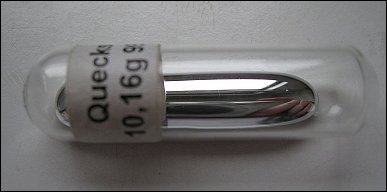Mercury
Author: Robert Husted, Mollie Boorman
| Atomic Number |
80 |
| Atomic Symbol |
Hg |
| CAS ID No. |
7439-97-6 |
| Atomic Weight |
200.5900 amu |
| Electron Configuration |
[Xe] 4f14 5d10 6s2 |
| Melting Point |
-38.7 °C |
| Boiling Point |
357 °C |
| Density |
13.350 g/cm3 |
History
(Gk. hydoor, living and argyros, silver) Known to ancient Chinese and Hindus; found in Egyptian tombs of 1500
B.C. Mercury is the only common metal liquid at ordinary temperatures. It only rarely
occurs free in nature. The chief ore is cinnabar; Spain and Italy produce about 50% of the
world's supply of the metal. The commercial unit for handling mercury is the
"flask," which weighs 76 lb. The metal is obtained by heating cinnabar in a
current of air and by condensing the vapor.
Properties
 |
| Ref.: Wikimedia Commons, user Dnn87. |
It is a heavy, silvery-white metal; a rather
poor conductor of heat, as compared with other metals, and a fair conductor of
electricity. It easily forms alloys with many metals, such as gold, silver, and tin, which
are called amalgams. Its ease in amalgamating with gold is made use of in the recovery of
gold from its ores. The most important salts are mercury chloride (corrosive sublimate - a
violent poison), mercurous chloride (calomel, occasionally still used in medicine),
mercury fulminate, a detonator widely used in explosives, and mercuric sulfide (vermilion,
a high-grade paint pigment). Organic mercury compounds are important. It has been found
that an electrical discharge causes mercury vapor to combine with
neon, argon, krypton,
and xenon. These products, held together with van der Waals' forces, correspond to HgNe,
HgAr, HgKr, and HgXe. Mercury is a virulent poison and is readily absorbed through the
respiratory tract, the gastrointestinal tract, or through unbroken skin. It acts as a
cumulative poison and dangerous levels are readily attained in air. Air saturated with
mercury vapor at 20°C contains a concentration that exceeds the toxicity limits. The
danger increases at higher temperatures. It is important therefore that mercury be handled
with care. Containers of mercury should be securely covered and spillage should be
avoided. If it is necessary to heat mercury or mercury compounds, it should be done in a
well-ventilated hood. Methyl mercury is a dangerous pollutant and is now widely found in
water and streams. The triple point of mercury, -38.8344°C, is a fixed point on the
International Temperature Scale (ITS-90).
Uses
The metal is widely used in laboratory work for making thermometers, barometers,
diffusion pumps, and many other instruments. It is used in making mercury-vapor lamps and
advertising signs, etc. and is used in mercury switches and other electronic apparatus.
Other uses are in making pesticides, Mercury cells for caustic soda and
chlorine
production, dental preparations, anti-fouling paint, batteries, and catalysts.
|


 Chemical Elements
Chemical Elements  Transition Metals
Transition Metals  Group 2B
Group 2B  Mercury
Mercury





 Chemical Elements
Chemical Elements  Transition Metals
Transition Metals  Group 2B
Group 2B  Mercury
Mercury

